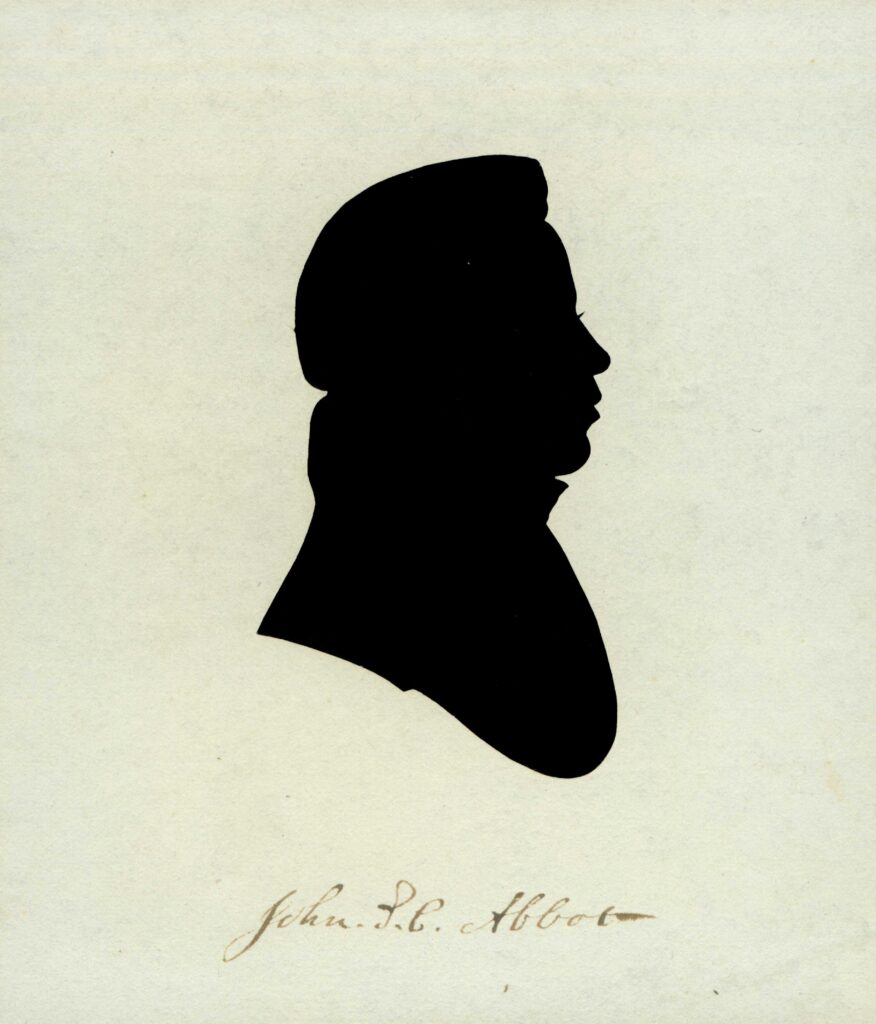
Parenting “Expert” and Bad Historian
John Stevens Cabot Abbott was born in Brunswick in 1805. The Brunswick Abbotts were a well respected family. John’s grandfather was a state senator and one of Bowdoin’s first overseers. John’s father, Jacob Abbot, was a lawyer and landowner who was also a Bowdoin overseer. Two of John’s brothers, Gorham and Jacob, became authors. Jacob was especially successful. He graduated from Bowdoin in 1820 and went on to write more than 180 children’s books. For this reason the Abbotts were considered “a household devoted to education and letters.” John was also related to Charles Abbott of Castine, who would later join him in the class of 1825. Abbott grew up in Brunswick and prepared for college under Alpheus S. Packard, a respected tutor who became a Bowdoin professor.
Around the age of sixteen, Abbott matriculated at Bowdoin. He lived at home his first year, but had the company of Joseph Jenkins Eveleth, George Washington Lane, John Odlin Page, and William Stone, who roomed with his family. Sophomore year, Abbott moved away from home to live at Mr. J. Grow’s with Eveleth, Richmond Bradford, George Barrell Cheever, and Cyrus Hamlin Coolidge. Junior and senior years Abbott lived on-campus in Winthrop Hall. The Peucinian society welcomed Abbott as a member. In terms of friends, Samuel Page Benson and Cullen Sawtelle held Abbott in high regard. Abbott also got in trouble with Patrick Henry Greenleaf his junior year for throwing a bonfire, suggesting a connection between the two men. Beyond the bonfire incident, Abbott appears a few times in the Executive Government records for unexcused absences. Abbott was not the best scholar in his class but was sometimes honored. At his senior exhibition he participated in a conference on “The Characters of Luther, Calvin, and Knox as Reformers” with Coolidge and Alfred Mason. At Commencement Abbott took part in another conference called, “The Writings of Byron, Scott, and Irving” along with John Dafforne Kinsman and Seward Wyman. Abbott graduated ranked as sixteenth in the class and was elected to Phi Beta Kappa.
Initially, after receiving his B.A., Abbott decided to remain in Brunswick and attend the Maine Medical School. However, for unknown reasons he dropped out in 1827, one year short of obtaining his M.D. He received an M.A. in 1828 and moved to Amherst Massachusetts, where he spent a year as a principal of an academy. Next, Abbott went to study at the Andover Theological Seminary. In this way, he followed the footsteps of his brother Jacob, who turned to teaching and then Andover directly after Bowdoin. Abbott’s first job after the seminary was as a pastor at the Calvinist Church in Worcester, Massachusetts. There, he gave a “famous series of lectures about parenthood to a mother’s association of his parishioners.” Motherhood was a theme Abbott returned to when in 1833 he published his first book, The mother at home: or, The principles of maternal duty familiarly illustrated. His main argument was that mothers had a moral responsibility to raise their children to be obedient and religious. Abbott’s guide became a huge success. It was often reprinted, translated into multiple languages, and read widely. Emily Dickinson’s parents reported using Abbott’s books to raise their children. While in Worcester, Abbott also had the opportunity to put these lessons into practice. He married a woman named Jane Williams Bourne, and, in the years to follow the couple had eight children.
Abbott left Worcester in 1835 and moved to Roxbury, Massachusetts, to take over their Eliot Church. Five years later he became the pastor of the First Congregational Church in Nantucket, Massachusetts. He also published a few more books dealing with the religious education of school-children. Then, in 1844, the Abbott family moved to New York City, where John reconnected with his brother Jacob and the pair founded a women’s school named the Abbott Institute. Abbott moved back to Brunswick in 1851 and bought his childhood home. Here, he became one of Bowdoin Overseer’s and a full-time author. Abbott switched his focus from parenthood to history, publishing dozens of short biographies on historical figures. However, these books faced a very cold reception in comparison to Abbott’s previous works. According to a biographer, Abbott was “not a scholar nor did he pretend to be one.” He cared more about emotional narratives than accurate research and, as such, critics faulted him for over-moralizing, melodrama, and a tendency to hero-worship. Still, Abbott was unfazed by this criticism, claiming that “It has been my endeavor to make the inhabitants of this world, more brotherly, better and wiser.”
Abbott continued to write until the end of his life, but he did not remain in Brunswick. In 1859, he moved to Farmington, Maine, where he resumed his career as a preacher. Between 1861 and 1866 he worked as a clergyman in New Haven, Connecticut. Finally, in 1866, he completely retired from preaching and moved to Fair Haven, Connecticut. In 1872, Abbott became the guardian of an eleven-year old Japanese girl named Shige Nagai. Shige came to America through the Japanese Embassy and stayed with the Abbott family until 1878. Shige later went on to become one of Japan’s first piano teachers and an advocate for women’s educator.
In 1875, Abbott returned to Brunswick for the 50th reunion of the class of 1875. Classmate Cullen Sawtelle relates an anecdote in which he sat next to Abbott on the train to Maine. At first, neither man recognized the other, but upon realizing they were both travelling to the reunion they remembered each other and broke into tearful rejoicing. At the reunion, Abbott gave the history of the class, which classmate David Shepley described as “ correct in the main, but quite too flattering to the majority.” Abbott also received an honorary Doctor of Divinity in 1875. He passed away two years later, at the age of 71. He left behind a large family and some of his descendants would go on to follow his literary path.